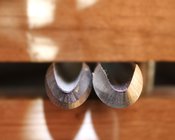I just searched and read what I could find about flute shapes on bowl gouges, I am wanting to buy a new bowl gouge, either a D way or a Thompson, but I don't know which shape to order.
I have 2 Sorby gouges I have used for a few years, they are getting a little on the short side, and would like to stay with that flute shape, what ever that is on the Sorbys, I also have a Record Power V shape that I really don't care for.
If anyone could point me in the right direction
I have 2 Sorby gouges I have used for a few years, they are getting a little on the short side, and would like to stay with that flute shape, what ever that is on the Sorbys, I also have a Record Power V shape that I really don't care for.
If anyone could point me in the right direction

